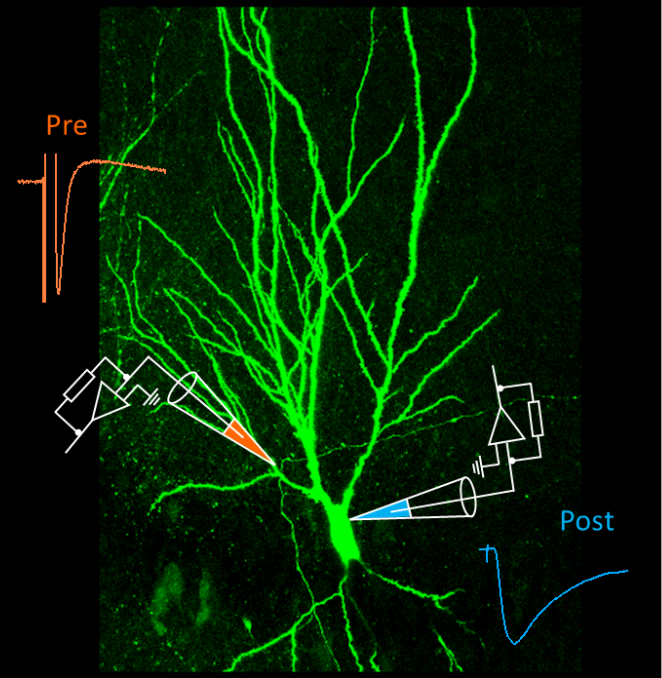May 18, 2021
Synaptic transmission: Not a one-way street
Key synapse acts as a “smart teacher”, sending messages against the usual flow of information in the brain. – Paper published in Nature Communications
When neuroscientists at the Institute of Science and Technology (IST) Austria analyzed the exact properties of nerve connections in the brain, they made a startling observation: At a key connection, or synapse, messages are sent against the usual stream of information. The study, published in the journal Nature Communications, reports that the signal glutamate likely plays a role in this unusual transmission.
Information flows in a well-defined direction in the brain: Chemical and electrical signals are passed from one neuron to the other across the synapse, from the pre-synaptic to the post-synaptic neuron. Now, Peter Jonas and his group at the Institute of Science and Technology Austria (IST Austria) show that information also travels in the opposite direction at a key synapse in the hippocampus, the brain region responsible for learning and memory. At the so-called mossy fiber synapse, the post-synaptic CA3 neuron influences how the pre-synaptic neuron, the so-called mossy fiber neuron, fires. “We have shown, for the first time, that a retrograde information flow is physiologically relevant for pre-synaptic plasticity,” says Yuji Okamoto, a postdoc in the group of Peter Jonas at IST Austria and co-first author of the paper published in Nature Communications.

The mossy fiber synapse is crucial for information storage in the neuronal network. Synaptic transmission is plastic meaning that a variable amount of chemical signal, the so-called neurotransmitter, is released into the synapse. To understand the mechanism of plasticity at work in this synapse, Okamoto precisely stimulated the pre-synaptic terminal of the mossy fiber synapse in rats and at the same time recorded from the post-synaptic neuron. “We need to know the synapse’s exact properties – with the numerical values, e.g., for its conductance – to create an exact model of this synapse. With his exact measurements, Yuji managed to obtain these numbers,” adds Peter Jonas, co-corresponding author with postdoc David Vandael.
Smart teacher reacts to overloaded student
Unexpectedly, the researchers found that the post-synaptic neuron influences plasticity in the pre-synaptic neuron. Previously, the mossy fiber synapse was assumed to be a “teacher synapse” that induces firing in the post-synaptic neuron. “Instead, we find that this synapse acts like a ‘smart teacher’, who adapts the lessons when students are overloaded with information. Similarly, the pre-synaptic mossy fiber detects when the post-synaptic neuron can’t take more information: When activity increases in the post-synaptic neuron, the pre-synaptic neuron reduces the extent of plasticity,” explains Jonas.
This finding raises the question of how the post-synaptic neuron sends information about its activity status to the pre-synaptic neuron. Pharmacological evidence points to a role for glutamate, one of the key chemicals or neurotransmitters used by neurons to send signals to other cells. Glutamate is also the transmitter that is released from pre-synaptic mossy fiber terminals. When calcium levels increase in the post-synaptic neuron – a sign that the neuron is active – the post-synaptic neuron may release vesicles with glutamate into the synapse. The glutamate travels back to the pre-synaptic neuron against the usual flow of neuronal information. “This retrograde modulation of plasticity likely helps to improve information storage in the downstream hippocampal network,” says Jonas, and he adds: “Once again, exact measurements have shown that reality is more complex than a simplified model would suggest.”

© David Vandael, IST Austria

© Yuji Okamoto, IST Austria

© IST Austria
Publication
David Vandael, Yuji Okamoto & Peter Jonas. 2021. Transsynaptic modulation of pre-synaptic short-term plasticity in hippocampal mossy fiber synapses. Nature Communications. DOI: 10.1038/s41467-021-23153-5
Funding information
The IST Austria project part was supported by funding from the European Research Council (ERC) under the European Union’s Horizon 2020 research and innovation program (grant agreement No 692692) and the Austrian Science Fund (Z 312-B27, Wittgenstein award), both to P.J.
Animal welfare
In order to better understand fundamental processes, for example, in the fields of neuroscience, immunology, or genetics, the use of animals in research is indispensable. No other methods, such as in silico models, can serve as alternatives. The animals were raised, kept, and treated according to the strict regulations of Austrian law.



